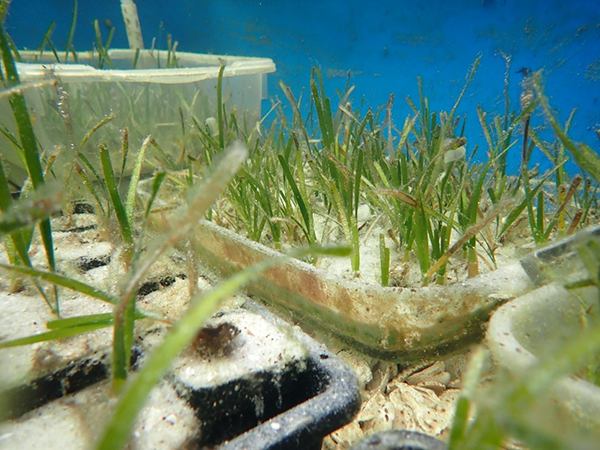St. Joe Community Foundation Grant awarded to St. Andrew and St. Joseph Bays Estuary Program for Seagrass Greenhouse Pilot Project
The St. Joe Community Foundation recently awarded a $13,034 grant to the St. Andrew and St. Joseph Bays Estuary Program (SASJBEP). The funds will be used to establish a greenhouse to grow seagrass seedlings for use in restoring seagrass beds in the bays.
“We are so grateful to St. Joe Community Foundation for investing in this important project,” said Jessica Graham, SASJBEP director. “We are excited to increase seagrass coverage in our bays and demonstrate the utility of greenhouse production.”

(FWC FWRI), St Petersburg, FL
Seagrass is one of the most vital and productive ecosystems in coastal waters. Seagrasses produce oxygen, stabilize sediments, reduce wave action, and help to keep our waters clear. They also provide critical habitat for many recreational and commercial fish and shellfish species, particularly scallops.
The scallop population has declined over the decades, along with a decline of seagrass acreage and coverage due to changes in water quality, propeller scarring, and urchin grazing.
The SASJBEP pilot project will test methods used in the Tampa Bay region that were successful in growing seagrass seedlings and promoting the restoration of seagrass beds.
According to Graham, common restoration practices include transplanting seagrass plants from host beds to restoration areas or using plants grown in greenhouses. Currently, there are no greenhouse facilities in our region.
“The SASJBEP project will show the viability of growing seagrass from seeds harvested from coastal Northwest Florida that will allow for bed restoration and increased coverage using locally acquired and grown seagrass plants,” Graham said.
The greenhouse will be located on the grounds of Florida State University Panama City. SASJBEP staff will begin seagrass surveys to identify flowering seagrass beds this spring to better identify areas where seagrass seeds will likely be produced. Turtle grass blooms in the spring and produces fruits in late summer. Once mature, each fruit releases 2 to 4 seedlings. Peak season for seedling dispersal is late July to early August.
After determining priority locations for collections, the SASJBEP will organize a volunteer event to help with the collection process of seagrass shoots and seedlings that have washed ashore in late summer. Our goal is to collect 1200.
Collected seagrass shoots and seedlings will be planted in the greenhouse tanks and monitored weekly for survival and growth over the fall and winter. SASJBEP will work with stakeholders and partners to determine the best use of surviving seedlings. If successful, the project will expand to accommodate additional seagrasses and capacity.
For more information about SASJBEP or to volunteer for the project when announced, visit https://pc.fsu.edu/sasjbep and follow us @SASJBEP.

